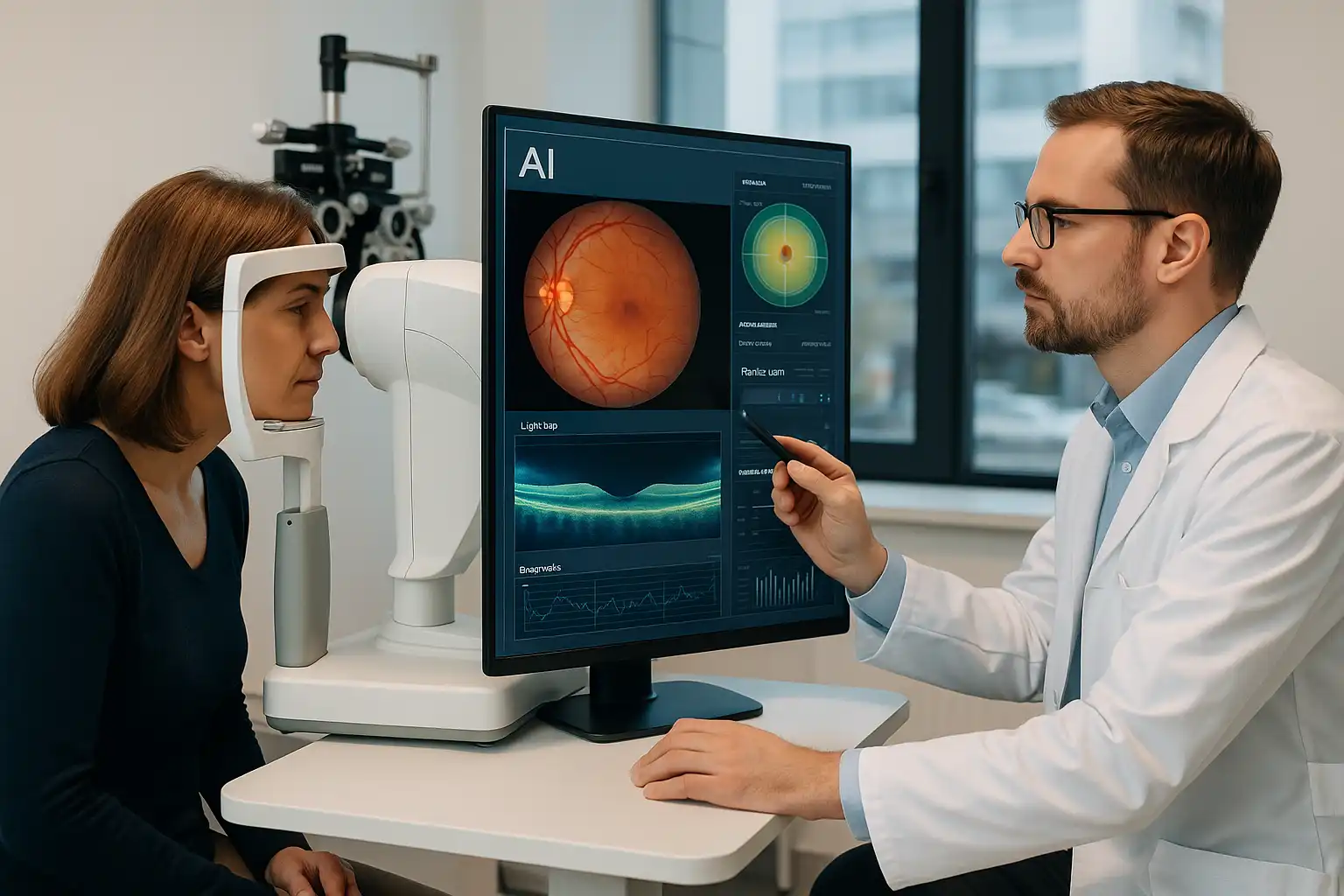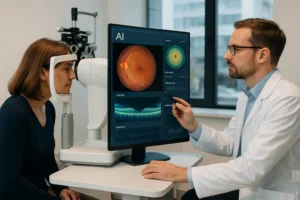In 2025, artificial intelligence (AI) and tele-optometry are transforming how patients access and experience vision care. What once required a full in-person clinic visit can now be conducted virtually with astonishing precision. The integration of smart diagnostic tools, real-time analytics, and secure telehealth platforms means that high-quality eye care is no longer limited by geography or scheduling challenges.
At BridgeMill Eye Care, we’ve seen how this shift empowers both patients and optometrists. Whether for early disease detection, remote monitoring, or follow-up care, AI and tele-optometry are creating faster, more personalized, and more affordable ways to protect vision health.
What Exactly Is Tele-Optometry?
Tele-optometry uses digital tools to deliver parts of an eye exam remotely. Patients can take visual acuity tests, upload retinal photos, or connect via live video with a licensed optometrist. These digital platforms make care possible for patients who previously struggled to reach an eye clinic—such as rural residents, seniors, or people with limited mobility.
According to the American Optometric Association, telehealth adoption has increased by 64% since 2022, and hybrid optometry models are becoming the new normal. These systems allow in-person precision combined with the convenience of virtual visits.
How AI Enhances Eye Exams
Artificial intelligence helps detect problems earlier, interpret data faster, and eliminate human error. Advanced imaging systems now use machine learning to scan thousands of retinal photos for micro-changes in blood vessels, optic nerves, or the cornea. AI doesn’t get tired—it processes complex patterns in seconds that might take a human several minutes or even hours to notice.
AI has already shown success detecting early signs of glaucoma, macular degeneration, diabetic retinopathy, and cataracts. Its precision allows doctors to focus on clinical decisions rather than manual data review. At BridgeMill Eye Care, this combination of human insight and technology leads to earlier intervention and better long-term results.
The Benefits of AI and Tele-Optometry for Patients
- Accessibility: Rural and homebound patients can connect with optometrists without traveling long distances.
- Speed: AI analysis provides near-instant results—often during the same appointment.
- Accuracy: AI detects subtle disease indicators invisible to standard imaging.
- Personalization: AI compares results to global data to tailor care plans for each individual.
- Cost Savings: Reduced travel, quicker diagnoses, and early prevention lower overall healthcare costs.
Inside an AI-Assisted Eye Exam
During a modern AI-integrated exam, the process begins as soon as the patient signs in. Smart software reviews medical history, family data, and lifestyle factors to predict risk levels. Then AI-powered retinal scanners capture detailed images and analyze them on the spot, flagging any abnormalities for review. Within minutes, your optometrist receives a comprehensive summary of findings with clear visuals.
For tele-optometry, patients use connected diagnostic tools—often compatible with smartphones or tablets—to perform parts of their exam from home. Measurements like visual acuity, astigmatism screening, or even intraocular pressure can be collected remotely and securely uploaded to the clinic’s system.
How AI Improves Diagnostic Precision
AI’s predictive power extends far beyond early detection. Using advanced datasets, it can calculate your probability of developing certain eye diseases years in advance. For example, algorithms tracking subtle retinal vessel changes can estimate a patient’s glaucoma risk up to five years before symptoms appear. This proactive model of care shifts the focus from reaction to prevention.
AI also supports clinical decisions during complex cases. If two diagnoses appear possible, the software can compare similar patient profiles and outcomes to suggest the most likely condition—helping the optometrist validate their findings with data-driven confidence.
Tele-Optometry at Home: The New Normal
Thanks to user-friendly diagnostic kits, patients can perform basic eye tests from the comfort of home. AI guides the process, ensuring accurate distance measurements, light levels, and focus calibration. Results are transmitted to the optometrist’s cloud dashboard in real time.
This hybrid approach is particularly valuable for patients managing chronic eye conditions like dry eye disease or diabetic retinopathy. Regular home monitoring reduces in-office visits while ensuring continuous supervision by the care team.
How AI and Humans Work Together
AI doesn’t replace optometrists—it enhances them. Machines can analyze data faster, but humans bring empathy, context, and judgment. Optometrists interpret the AI results, explain options, and provide treatment that considers lifestyle and emotional well-being. This partnership builds patient trust while improving accuracy.
At BridgeMill Eye Care, AI acts as a second set of eyes—never the only one. The technology ensures nothing is missed, while our doctors maintain full clinical oversight and personalized patient care.
Challenges and Ethical Considerations
Despite its advantages, AI in healthcare raises questions about privacy, bias, and accessibility. Retinal scans and personal health data must be stored securely using encrypted systems compliant with HIPAA standards. Developers must also train AI on diverse datasets to prevent diagnostic bias across age, ethnicity, or gender.
Equitable access is another concern. While major urban clinics easily adopt these systems, smaller rural practices may face high costs or limited broadband connectivity. To bridge this gap, the AOA and state health programs are launching funding grants for community optometry tech upgrades.
How AI Enhances the Patient Experience
Patients often describe AI-enhanced exams as quicker, clearer, and more engaging. Digital reports provide visuals of the eye in color-coded layers, helping patients understand their own health better. Instead of waiting days for lab results, patients can see diagnostic visuals during the appointment—encouraging proactive care.
AI also minimizes repetitive testing. Once your baseline data is saved, the system tracks subtle changes over time, reducing unnecessary procedures and focusing only on what matters most for your vision health.
Regulatory and Professional Oversight
California’s Board of Optometry and the FDA closely monitor AI diagnostic tools used in eye care. Approved systems must demonstrate accuracy comparable to traditional exams. Furthermore, any AI-based diagnosis must be verified by a licensed optometrist before results are shared with patients. This safeguard ensures medical accountability and quality control remain central to patient care.
The Future of Eye Care: Looking Ahead to 2026 and Beyond
As 2026 approaches, experts predict over 80% of optometry clinics will integrate AI-powered diagnostic imaging and remote follow-up tools. Smart lenses capable of continuously monitoring intraocular pressure or blood glucose are under clinical testing. Augmented-reality eyewear may soon sync with cloud-based eye health dashboards, giving patients real-time vision insights.
Meanwhile, tele-optometry platforms will expand further, offering multilingual virtual consultations and AI-generated treatment reminders. This evolution supports preventive care for global communities, improving both convenience and long-term outcomes.
Final Thoughts
The future of vision care lies in the harmony between human expertise and artificial intelligence. AI and tele-optometry empower optometrists to provide smarter, faster, and more inclusive care while giving patients control over their own eye health journey. As technology continues to evolve, practices like BridgeMill Eye Care remain committed to blending innovation with compassion—ensuring every patient enjoys clearer vision and a brighter future.
To explore more innovations shaping the industry, read our articles on AI in Optometry and Smart Lenses & AR Eyewear.





